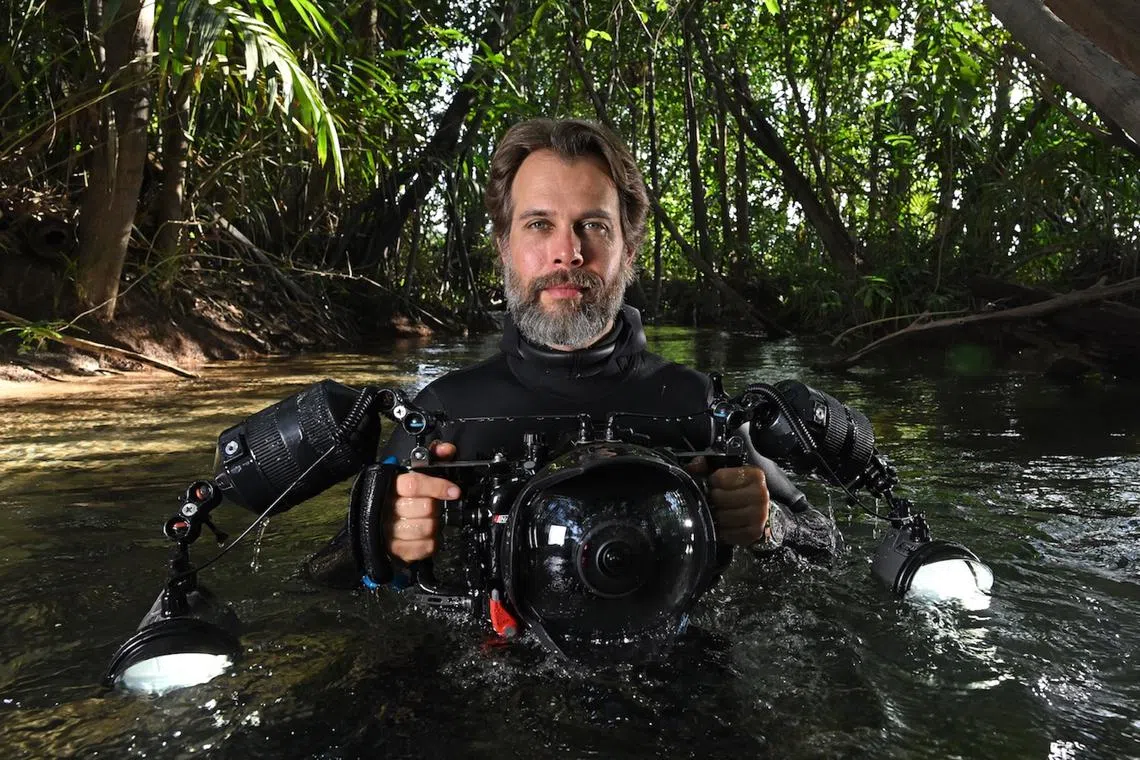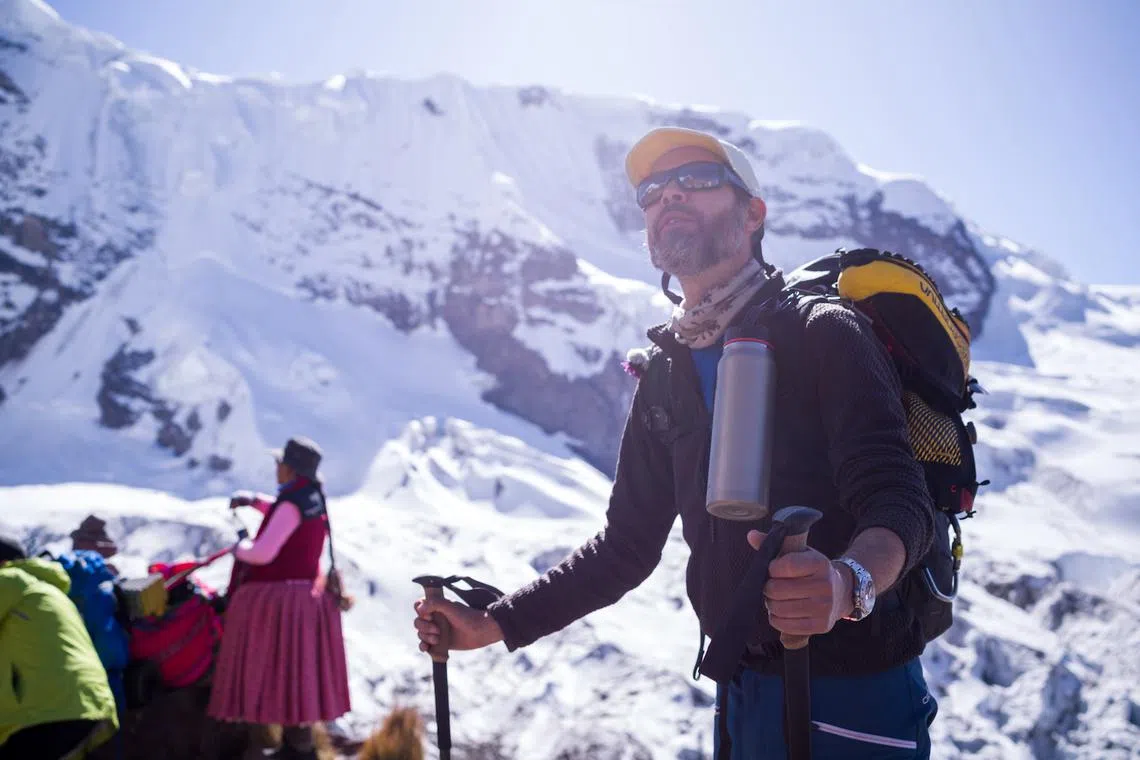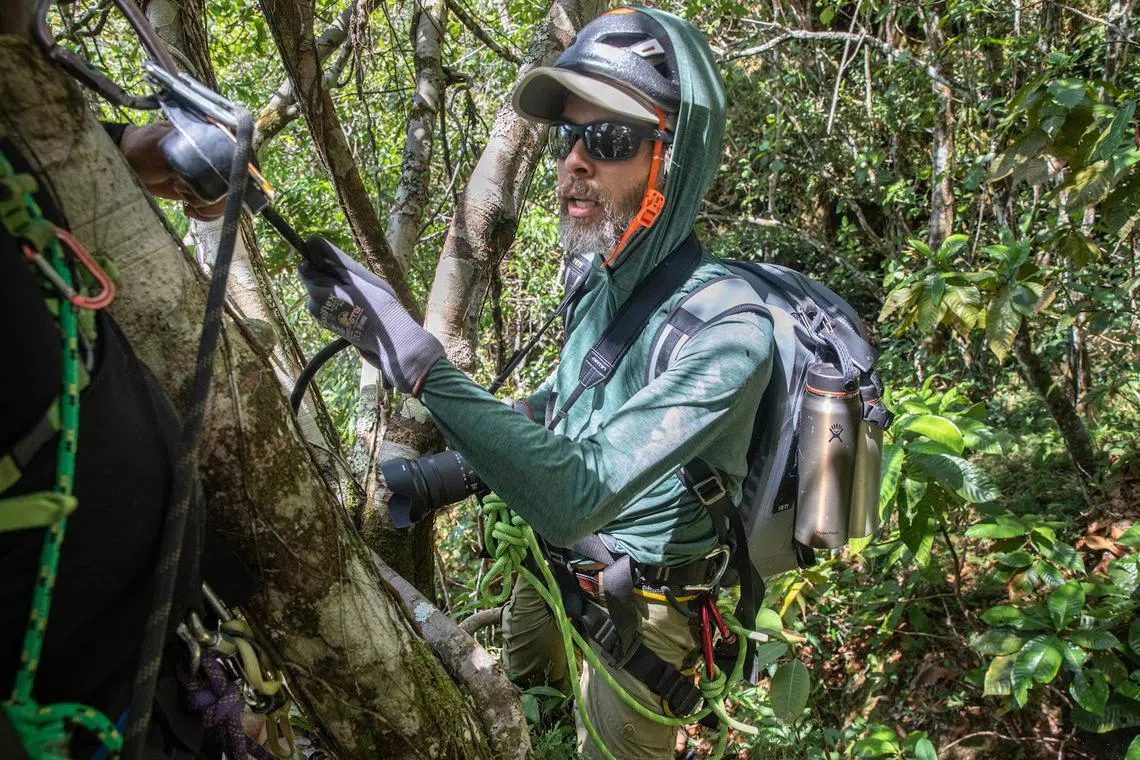IN PARTNERSHIP WITH ROLEX
Capturing 500,000 pictures in 400 days: Why he’s using photography to tell stories that ‘nobody knows about’
With support from the Rolex Perpetual Planet Initiative, National Geographic Explorer and photojournalist Thomas Peschak embarked on challenging research expeditions to bring the Amazon River system to life in pictures to protect it

Photojournalist Thomas Peschak joined Rolex and National Geographic Perpetual Planet Amazon Expedition team to capture the lives of the people and wildlife across the Amazon River basin.
PHOTO: OTTO WHITEHEAD/NATIONAL GEOGRAPHIC
Follow topic:
A single photograph can reveal the hidden wonders of our underwater world and why we must protect them.
This belief drives award-winning photojournalist and National Geographic Explorer Thomas Peschak, whose lens has illuminated the depths of our planet’s most vital waterways for over a decade.
Over the past few years, the German, 49, joined seven teams of National Geographic Explorers on an assignment that ranks among his most memorable: A series of expeditions across the Amazon River basin to study its vast waterways’ ecology and health, organised by the National Geographic Society and Swiss watchmaker Rolex through its Perpetual Planet Initiative.
In one of the expeditions, he waited in the black waters of the Rio Negro tributary in Brazil, biding his time and springing into action when a pod of pink river dolphins surged into view. The Amazon River basin is among the safe harbours for the rapidly disappearing species, with conservationists aiming to safeguard its remaining numbers.
“Spending three weeks in the water with the pink dolphins, experiencing their inquisitiveness and curious nature, and me being able to explore the underwater – what was the flood of the forest – through their perspective was a real eye opener,” says Mr Peschak in the Perpetual Planet Live Talk conducted by Rolex on Nov 21.
Besides the pink dolphins, he also spotted an extremely rare sight in the flooded forest in the Rio Negro tributary. “Coming across a swimming sloth – that is a behaviour that I’ve read about for years and years – was a highlight for me. And I was told by the scientists that this is incredibly rare. You have to be incredibly lucky. You have to be in the right place at the right time,” he enthuses.

Mr Peschak spent three weeks in the water with river dolphins as part of documenting a study on the mammal throughout the Amazon River and its tributaries.
PHOTO: FERNANDO TRUJILLO/NATIONAL GEOGRAPHIC
While the Amazon’s rainforests have dominated many conversations, the Amazon River and its tributaries are equally vital, both to the surrounding communities, who depend on them for food, water and transport, and to the environment. The blue passages channel the largest volume of rainfall on Earth, feeding the landscape and delivering freshwater to oceans.
As the seven teams – which spanned experts from ecology, biology, geochemistry, hydrology and other fields – installed instruments, collected data and conducted other research to find out how climate change, deforestation and other issues are threatening the waterways, Mr Peschak documented their work and the ecosystems’ beauty, vivid life and fragility.
He explains: “From the Andes mountain range to the Atlantic Ocean, the 6,400km-long Amazon River and its thousands of tributaries are the region’s lifeblood. This is an aquatic wilderness the size of Australia, but we rarely get to experience the Amazon through an aquatic lens. It was critical to show how amazing these ecosystems are.”
Mr Peschak’s images are also lifting the veil on a watery realm that is shrouded in mystery for most people across the world. Underwater photography in the Amazon is severely lacking as many of the region’s murky waters are dangerous or inaccessible. “The story of this rarely glimpsed aquatic underworld is the most complex that I have ever told in my life,” he adds.
With his photographs, he hopes to move people and spur them to help conserve the habitats. He says: “We need more than just researchers to care about the Amazon River basin. We need everybody to care. We need the scientific papers, but we also have to marry that wisdom with popular storytelling to reach as large an audience as possible.
“I’m looking for those things that the world has never seen before. I want to take you all to a place that nobody knows about. I don’t want to rehash the same image or the same narrative you’ve heard again and again. I want to show you things that are completely new to you.”
Connectivity between ‘people, animals, river and rainforest’
For Mr Peschak, who began his career as a marine biologist before turning to photojournalism, the expeditions were a study in extremes. At the Nevado Ausangate mountain in the tropical Andes, a key water source for the Amazon, he tried for days to snap a shot that showcases the peak’s majesty, eventually photographing it at night as it peeked out from behind clouds.

Mr Peschak and the team prepare to leave after camping along the route to the summit of Nevado Ausangate.
PHOTO: JUSTUS BRUNS/NATIONAL GEOGRAPHIC
At the other end of the Amazon basin, as its river system empties into the Atlantic Ocean, the deluge of freshwater creates a long “plume” stretching all the way to the Caribbean, carrying nutrients that nourish marine life. Mr Peschak followed the “plume” to the Caribbean, where he took an image of two leatherback turtle hatchlings that benefit from the nutrients.
He emphasises: “Most people believe the Amazon’s journey ends at its mouth. However, the ‘plume’ spreads northwards for thousands of miles, right across the Caribbean, where we find an ecosystem that’s still influenced by the iconic river system.” Sargassum seaweed and barrel sponges are just some of the other species that rely on the Amazonian water.
Heat, bees and heavy load: Overcoming expedition adversity
Throughout his career as a photojournalist, Mr Thomas Peschak has been through varying levels of discomfort while documenting nature’s wonders.

Life during the National Geographic Perpetual Planet Amazon Expedition was not easy for Mr Thomas Peschak as he had to, for instance, battle intense heat and sweat bees in Columbia’s Chiribiquete National Park.
PHOTO: ANDY WHITWORTH/NATIONAL GEOGRAPHIC
But with the National Geographic Perpetual Planet Amazon Expedition team, it was a different experience altogether. Out in Columbia’s Chiribiquete National Park, it was unbearably hot. “While the campsite might look idyllic, it felt like I have set up my camp on a rocky furnace,” says the National Geographic Explorer, who had to be constantly wrapped up from head to toe to avoid large swarms of harmless sweat bees
Constantly drenched by his sweat with nary a breeze, he also had to battle against mental struggles. “You’re just suffering, you’re losing weight, you’re getting sick, you’re hot, you’re miserable and you want to go home. But what drives me is passion.”
Physical and mental challenges were not the difficulties he faced. Logistics was another issue. For him to properly document the work of the expedition team, he needed to bring a substantial amount of equipment.
Not counting the camera and outdoor equipment needed, each expedition also required unique gear.
“When you’re in the Andes, you are at minus 20 degrees Celsius and up at 6,000 metres. You are in down suits with ice axes and crampons and tents,” he says. “And when you’re in the lowlands rainforest, then you’re in scuba gear and trying to dive in these remote places.”
Gear is always a major headache, he notes. But they are critical for his mission. He says: “As much as I’d love to just use one camera and one lens, there’s a great saying where, you know, one is none, two is one, three is two. You always have to back up for backup. So that makes it a very intensive endeavour.”
While Mr Peschak has spent his career documenting different aspects of nature’s wonder, he notes that he has learnt a lot from the different experts he met on the different expeditions.
Admitting that he did not spend the last few decades researching on the same subject, he explains: “I rely on experts all the time, you know, whether those are PhD researchers who’ve dedicated their lives to documenting Andean bears or to conserve dolphins or to work on the impacts of mining. And I also rely on indigenous scientists – the people whose backyard is the Amazon.
“They have been living in the Amazon for millennia. And the knowledge that indigenous people hold is equivalent to or even more complex and sophisticated than many of the Western scientists have.”

Having taken 500,000 photographs across 40 locations, Mr Peschak (seen at the Chiribiquete National Park) admits taking a long time to review the images and decide which work best for telling stories.
PHOTO: ANDY WHITWORTH/NATIONAL GEOGRAPHIC
In all, Mr Peschak spent over 400 days with the teams, taking half a million photographs across 40 locations. He credits the achievement to support from Rolex and the National Geographic Society.
“I think in 25 years of telling environmental conservation stories all around the world, this was the single most challenging and hardest thing I’ve ever done. And for something as bold, unique and ambitious as this, there weren’t better partners than National Geographic and Rolex. There’re very few other organisations out there which could have pulled this off because we really pushed the limits here,” he explains.
The feat is also in line with the watchmaker’s extensive history, going back nearly a century, of enabling pioneering explorers to push the boundaries of human endeavour.
With climate change and other threats to natural ecosystems worldwide, the brand has moved from championing exploration for the sake of discovery to protecting the planet, committing for the long term to empower individuals and organisations using science to better understand and address today’s environmental challenges.
In 2019, it strengthened this engagement with its Perpetual Planet Initiative, which initially focused on the Rolex Awards and longstanding partnerships with the National Geographic Society and Mission Blue. The latter is a non-profit organisation founded and led by legendary oceanographer Sylvia Earle, who is also a Rolex Testimonee, to explore and protect oceans.
The Initiative now has a diverse, expansive and growing portfolio of over 30 partnerships that concentrate on ocean conservation, wilderness protection and the living world’s preservation, including with Rewilding Argentina and Rewilding Chile, which protect landscapes in South Africa, Under The Pole expeditions for underwater exploration, and Rolex Awards Laureates.
Rolex also supports organisations and initiatives that foster the next generations of explorers, scientists and conservationists through scholarships and grants. These include the Our World-Underwater Scholarship Society and The Rolex Explorers Club Grants that help talented young people to unlock their full potential, including by gaining experience in their chosen fields.
Mr Peschak notes that such partnerships were crucial to the Amazon expeditions themselves. “It was the union of Rolex and the National Geographic Society, the explorers, scientists and community members, that made our mission possible. We hope to show the world the deep connectivity that we uncovered too, between the people, animals, river and rainforest.”
We The Earth Rolex and its Perpetual Planet Initiative

